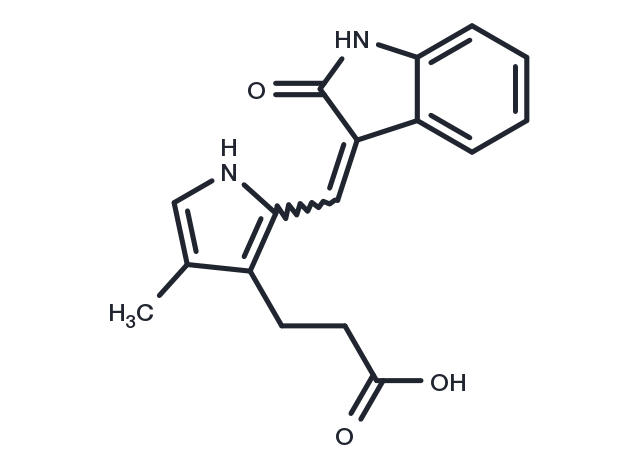Powder: -20°C for 3 years | In solvent: -80°C for 1 year


SU 5402 is a potent multi-targeted receptor tyrosine kinase inhibitor with IC50 of 20 nM, 30 nM, and 510 nM for VEGFR2, FGFR1, and PDGF-Rβ, respectively.

| Pack Size | Availability | Price/USD | Quantity |
|---|---|---|---|
| 5 mg | In stock | $ 59.00 | |
| 10 mg | In stock | $ 93.00 | |
| 25 mg | In stock | $ 169.00 | |
| 50 mg | In stock | $ 283.00 | |
| 100 mg | In stock | $ 455.00 | |
| 1 mL * 10 mM (in DMSO) | In stock | $ 65.00 |



| Description | SU 5402 is a potent multi-targeted receptor tyrosine kinase inhibitor with IC50 of 20 nM, 30 nM, and 510 nM for VEGFR2, FGFR1, and PDGF-Rβ, respectively. |
| Targets&IC50 | PDGFRβ:510 nM, FGFR1:30 nM, VEGFR2:20 nM |
| In vitro | SU5402 inhibits VEGF-, FGF-, PDGF- dependent cell proliferation with IC50 of 0.05 μM, 2.80 μM, 28.4 μM, respectively. [1] In HUVECs, SU5416 selectively inhibits VEGF-driven mitogenesis in a dose-dependent manner with IC50 of 0.04 μM. [2] In nasopharyngeal epithelial cells, SU5402 attenuates LMP1-mediated aerobic glycolysis, cellular transformation, cell migration, and invasion. [3] In mouse C3H10T1/2 cells, SU 5402 diminishes the effect of FGF23 on cell differentiation. [4] |
| In vivo | In mice, SU5416 (25 mg/kg, i.p.) inhibits subcutaneous growth of a panel of tumor cell lines by inhibiting the angiogenic process associated with tumor growth. [2] |
| Kinase Assay | FGF-R1 and Flk-1/KDR kinase assays.: The catalytic portion of FGF-R1 and Flk-1/KDR are expressed as GST fusion proteins following infection of Spodoptera frugiperda (sf9) cells with engineered baculoviruses. GST-FGFR1 and GST-Flk1 are purified to homogeneity from infected sf9 cell lysates by glutathione sepharose chromatography. The assays are performed in 96-well microtiter plates that had been coated overnight with 2.0 μg of a polyGlu-Tyr peptide (4:1) in 0.1 mL of PBS per well. The purified kinases are diluted in kinase assay buffer (100 mM Hepes pH 7.5, 100 mM NaCl, and 0.1 mM sodium orthovanadate) and added to all test wells at 5 ng of GST fusion protein per 0.05 mL volume buffer. Test compounds are diluted in 4% DMSO and added to test wells (0.025 mL/well). The kinase reaction is initiated by the addition of 0.025 mL of 40 μM ATP/40 mM MnCl2, and plates are shaken for 10 min before stopping the reactions with the addition of 0.025 mL of 0.5 M EDTA. The final ATP concentration was 10 μM, which is twice the experimentally determined Km value for ATP. Negative control wells receive MnCl2 alone without ATP. The plates are washed three times with 10 mM Tris pH 7.4, 150 mM NaCl, and 0.05% Tween-20 (TBST). Rabbit polyclonal anti-phosphotyrosine antiserum is added to the wells at a 1:10000 dilution in TBST for 1 h. The plates are then washed three times with TBST. Goat anti-rabbit antiserum conjugated with horseradish peroxidase was then added to all wells for 1 h. The plates are washed three times with TBST, and the peroxidase reaction is detected with the addition of 2,2‘-azinobis(3-ethylbenzthiazoline-6-sulfonic acid) (ABTS). The color readout of the assay is allowed to develop for 20?30 min and read on a Dynatech MR5000 ELISA plate reader using a 410 nM test filter. |
| Cell Research | Tumor cell lines used in the in vitro growth are cultured in media at 37°C in 5–10% CO2. SU5416 is serially diluted in media containing DMSO (<0.5%) and added to cultures of tumor cells 1 day after the initiation of culture. Cell growth is measured after 96 h using the sulforhodamine B method. IC50s are calculated by curve fitting using four-parameter analysis.(Only for Reference) |
| Synonyms | SU5402 |
| Molecular Weight | 296.32 |
| Formula | C17H16N2O3 |
| CAS No. | 215543-92-3 |
Powder: -20°C for 3 years | In solvent: -80°C for 1 year
DMSO: 29.6 mg/mL (100 mM)
You can also refer to dose conversion for different animals. More
bottom
Please see Inhibitor Handling Instructions for more frequently ask questions. Topics include: how to prepare stock solutions, how to store products, and cautions on cell-based assays & animal experiments, etc.
SU 5402 215543-92-3 Angiogenesis Tyrosine Kinase/Adaptors VEGFR FGFR PDGFR inhibit Inhibitor Fibroblast growth factor receptor SU5402 Platelet-derived growth factor receptor SU-5402 Vascular endothelial growth factor receptor inhibitor
